Physical Address
304 North Cardinal St.
Dorchester Center, MA 02124
Infection of the musculoskeletal system is encountered in everyday clinical practice and the scope of this chapter includes both osteomyelitis and soft-tissue infection. Osteomyelitis is defined as infection of the bone marrow and adjacent osseous structures, with or without extension into the soft tissues. It is generally categorised as acute, subacute or chronic based on the clinical course and histopathological findings. Acute osteomyelitis presents with symptoms typically within 2 weeks of infection and is associated with acute inflammatory changes in the bone marrow. In chronic osteomyelitis, there is presence of necrotic bone and symptoms may be delayed until 6 weeks after onset of infection. The route of infection is usually haematogenous spread but can also occur due to direct inoculation or spread from contiguous soft tissue. Infection in the soft tissues can involve differing anatomical planes such as skin and subcutaneous tissues (cellulitis), fascia (fascitis), muscles (myositis or pyomyositis) or joints (septic arthritis). Abscesses can result from infection either in the bone or the soft tissues. One of the greatest challenges of osteomyelitis is to be able to diagnosis early stages of infection in order to provide prompt treatment and prevent long-term debilitating sequelae. Imaging plays a key role in the early diagnosis of musculoskeletal infection and a variety of techniques, including radiography, computed tomography (CT), scintigraphy and magnetic resonance imaging (MRI), are often used to aid in diagnosis.
Conventional radiography is usually the initial investigation in the setting of suspected musculoskeletal infection. Radiographs can be normal at the outset and it can take up to 2 weeks for changes to become apparent as periosteal reaction takes time to become radiographically apparent and approximately 50% of the trabecular bone needs to be destroyed for lysis to be visible on the plain radiograph. Ultrasound (US) is useful in soft-tissue infection and helps in detecting joint effusions and fluid collections and also demonstrating subperiosteal abscesses in paediatric patients. It is also useful in guiding aspiration or biopsy in order to establish diagnosis. CT is useful in chronic osteomyelitis to identify the extent of bone destruction and also to demonstrate any sequestra. CT can also identify gas in the soft tissues in certain aggressive infections. Scintigraphy is extremely sensitive for the diagnosis of infection (although not perfectly specific) but anatomical detail is limited. It remains useful in a diagnosis of infection in the presence of an implant. MRI has a number of advantages and is the best investigation to detect early osteomyelitis compared with other imaging techniques. It is extremely sensitive and can detect osteomyelitis within 3 to 5 days of disease onset. Although not specific for infection, it has a high negative predictive value in excluding infection. Osteomyelitis has a variable imaging appearance and often mimics other bone diseases. It is important that the radiologist is familiar with the clinical spectrum of presentations, appropriate diagnostic tests and the need to perform these without delay to enable prompt management.
Staphylococcus aureus is the commonest organism causing bone and joint infections in any age group, accounting for up to 80% of cases of osteomyelitis. Gram-negative organisms, including Pseudomonas and Enterobacter , are responsible for most of the remaining 20% of cases. Acute infections of prosthetic implants are usually caused by S. aureus . Coagulase-negative staphylococci such as Staphylococcus epidermidis account for most chronic osteomyelitis associated with orthopaedic implants and account for approximately 90% of pin tract infections. Bacteria adhere to bone matrix and orthopaedic implants via receptors to fibronectin and other receptor proteins. They form a slimy coat and elude the host defence mechanisms by hiding intracellularly and by developing a slow metabolic rate. Polymicrobial infection occurs in most cases of osteomyelitis affecting the diabetic foot, comprising of mixed gram-positive and gram-negative bacteria. Wound swabs are often inaccurate and dominated by contaminants. Cultures from bone biopsy or operative specimens are more reliable in planning appropriate antibiotic treatment. Brodie abscess, a true small, focal intraosseous collection of pus, is an uncommon manifestation of bone infection, except in East Africa, where reportedly it is a common occurrence. S. aureus is again the predominant organism cultured in these patients.
Vertebral osteomyelitis usually results from haematogenous seeding or by direct inoculation at the time of spinal surgery. S. aureus is the commonest microorganism amongst others that include methicillin-resistant S. aureus (MRSA), streptococci and Escherichia coli . As with other orthopaedic implants, coagulase-negative staphylococcal infections are seen after usage of fixation devices.
In children, other than staphylococci, Haemophilus influenzae type b, Streptococcus pneumoniae and Streptococcus pyogenes also occur. One of the significant changes in the epidemiology of bone and joint infections is the increasing incidence of MRSA and the emergence of multidrug-resistant (MDR) organisms.
Osteomyelitis complicating war injuries are predominantly caused by MDR organisms and include MRSA, Enterobacteriaceae and Acinetobacter . There is commonly a history of previous surgical procedures and these conditions usually need more aggressive management.
Fungal infections of the bone and joints are uncommon and occur predominantly in the immunosuppressed patient. Such infection may resemble tuberculous disease and present as chronic multifocal osteomyelitis or polyarthritis.
Osteomyelitis can be classified by the type of infection or, more commonly, by the duration since onset of the illness. Acute osteomyelitis is defined as infection diagnosed within 2 weeks of onset of symptoms whilst subacute osteomyelitis is diagnosed if symptoms exceed 2 weeks’ duration. If the infection is diagnosed months after the onset of symptoms, then it is defined as chronic osteomyelitis. There are, however, other classifications in the literature, depending on the anatomical areas of bony involvement and on pathogenesis.
Paediatric, unlike adult, bone infections more commonly occur in healthy bones, without pre-existing trauma. The usual route of infection is haematogenous, via the arterial blood supply. Acute haematogenous osteomyelitis (AHO) is the most common form of bone infection in children. About 50% of cases occur in children less than 5 years of age and it is twice as common in boys than in girls. Immunocompromised children and children with underlying haematological disorders such as sickle cell disease are more prone to these infections. Infections are commonest in long bones such as the femur, tibia or humerus, with most cases limited to single bone involvement. Less than 10% of cases involve two or more locations, the corollary of which is that multifocal involvement does not exclude acute osteomyelitis (the same is true for septic arthritis).
Haematogenous spread is the most common route to bones and joints, though implantation at trauma or surgery and spread from contiguous infection may also occur. Infection usually starts in the metaphysis due to its rich blood supply. From here the infection may spread to the bone cortex and penetrate the loosely attached periosteum, eliciting a periosteal reaction. It may perforate the periosteum and spread to adjacent muscles and soft tissues, forming abscesses. Less commonly, the infection may spread to the epiphyseal plates and joints, causing septic arthritis. In neonates, the metaphyseal capillaries form a connection with the epiphyseal plate, thus increasing the chance of joint infection. In later infancy, these vessels atrophy and there is thickening of the cortex, thus reducing the risk of growth plate involvement and septic arthritis.
S. aureus accounts for approximately 60%–90% of childhood AHO, followed by group A β-haemolytic streptococci (10%). Other causes include H. influenzae and S. pneumoniae . Salmonella infections were historically common in patients with sickle cell disease, but this seemed to reflect the organism prevalence in the population. Pseudomonas infections can be seen after puncture wounds of the feet. In neonates, again, S. aureus infections predominate, but group B streptococcus and E. coli infections are also common.
A few well-recognised clinical presentations of bone and joint infections are seen in children.
Acute osteomyelitis , more common in boys, usually occurs between ages 1 and 10 years. The lower limbs are usually involved. Children usually present with pain and reluctance to use the affected limb. The cardinal signs of acute inflammation, including pain, redness and swelling, may not be present initially, may develop later and may be associated with systemic illness. Often pain is localised and prompt diagnosis and treatment offer a good prognosis.
Chronic osteomyelitis has a more insidious onset over a few weeks and is more difficult to diagnose. There is usually minimal loss of function. Systemic signs are usually absent, but local tenderness may be present. Radiographs are usually helpful as bone changes are usually present by the time medical attention is sought. Chronic osteomyelitis is further discussed under adult infections.
Septic arthritis is also twice as common in boys, with a peak incidence below 3 years of age. Symptoms include pain and swelling around the joint with reluctance to move the limb. Pseudo-paralysis and painful passive movements may be present. There are systemic symptoms and there is rapid progression of symptoms. Diagnosis is more difficult in neonates. The joint is warm and ultrasound can demonstrate a joint effusion. The lower limbs are usually involved, particularly the hip or knee.
Neonatal osteomyelitis and septic arthritis are probably different manifestations of the same condition: 75% of the children are not severely ill and present as failure to thrive. Prognosis is not as good as there is usually a delay in diagnosis.
Disseminated staphylococcal disease presents as a rapidly progressive severe life-threatening illness with virulent bacteraemia and multiorgan involvement, but fortunately is rare.
Thorough clinical examination and laboratory investigations are extremely important in diagnosis, before imaging evaluation is performed. Conventional radiography is still one of the most important investigations for diagnosis. The other imaging investigations, ultrasound, CT, MRI and scintigraphic studies are also used. The risk/benefits and costs of these tests, their radiation exposure, requirements for sedation or anaesthesia need to be assessed carefully as investigations are planned.
In acute osteomyelitis, plain radiographs are extremely useful to exclude other lesions such as fractures, Perthes disease and slipped femoral epiphysis. In septic arthritis the joint space is initially expanded with fluid and may give rise to some asymmetry in the position of the epiphysis, but ultrasound is more reliable to demonstrate fluid in the joint. In subacute osteomyelitis, periosteal reaction, new bone formation and occasionally lucent lesions (Brodie abscess) in the metaphyseal region can be present. Chronic osteomyelitis demonstrates bone sclerosis, bone destruction and periosteal new bone formation.
Ultrasound (US) has an important role in demonstrating increased joint fluid early in acute septic arthritis and is also used to guide aspiration of the joint effusion for diagnostic and therapeutic purposes ( Fig. 46.1 ). In septic arthritis the cellular debris-laden effusion may be echoic, rendering it less conspicuous. Demonstrating movement of this debris by varying the ultrasound probe pressure during the examination may reduce false-negative interpretation. Subperiosteal abscess can be demonstrated as hypoechoic fluid along the bone surface in acute and subacute disease. Soft-tissue abscesses can also be seen as hypoechoic fluid with thick walls that may show increased colour Doppler flow. Direct aspiration under ultrasound guidance and culture and sensitivity of the aspirate is extremely helpful to confirm diagnosis and for further treatment with the appropriate antibiotics. Soft-tissue abnormalities can also be demonstrated with ultrasound, though MRI is more reliable.
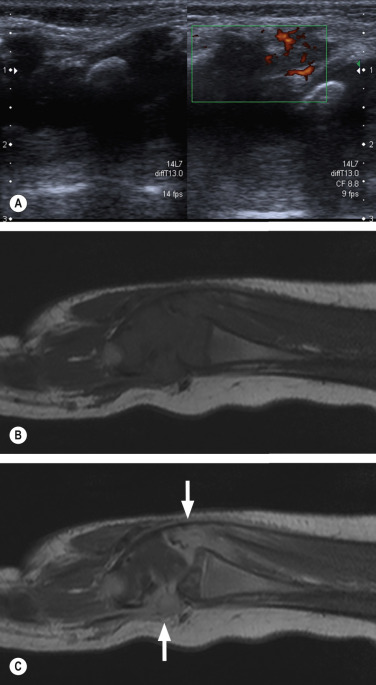
This investigation is less useful in a paediatric population due to its radiation dose and lack of specific advantages, and MRI is preferred.
MRI is the investigation of choice for the diagnosis of acute, subacute and chronic osteomyelitis with high sensitivity and specificity. The characteristic signs of acute osteomyelitis in children include bone marrow oedema, which is seen as low T 1 signal in the bone marrow, along with high signal on T 2 and short tau inversion recovery (STIR) images ( Fig. 46.2 ). Abscesses are seen both early and late in disease, as well-defined low-signal collections on T 1 , high signal similar to fluid on T 2 images, with enhancing walls following intravenous enhancement. This may be seen in the bone, adjacent soft tissues or subperiosteal location due to the loose attachment of the periosteum to the underlying bone in children. Septic arthritis is diagnosed by the presence of a joint effusion, abnormal bone marrow signal localised to either side of the joint or synovial thickening which also shows post-contrast enhancement. Physeal involvement is characterised by low T 1 and hyperintense T 2 signal along the growth plate associated with widening of the growth plate and enhancement on post-contrast imaging ( Fig. 46.3 ). Later in the course of the infection, chondrolysis occurs.
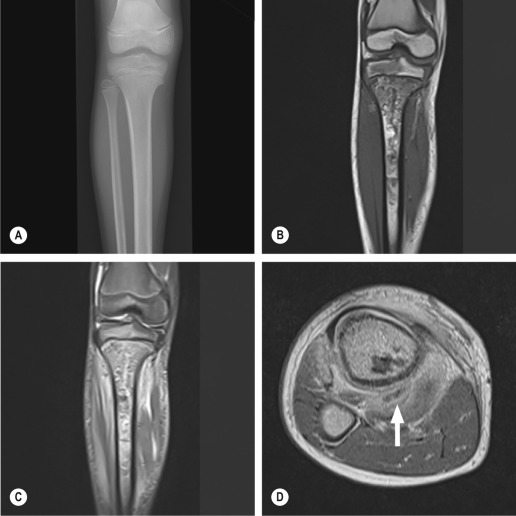
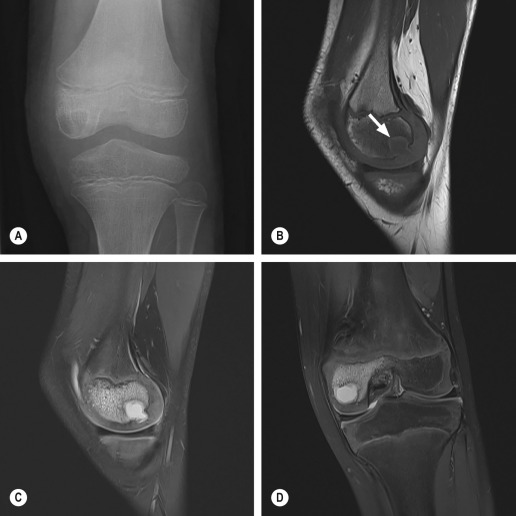
Fat-saturated T 1 weighted images with intravenous contrast medium can increase confidence in the diagnosis of osteomyelitis and also help diagnose complications such as septic arthritis, physeal involvement, intraosseous, subperiosteal and soft-tissue abscesses. Intravenous gadolinium is most useful to identify non-enhancing abscess collections within a background of soft-tissue and bone marrow oedema and to aid differentiation between granulation tissue and true abscess. It is generally not useful if unenhanced images show no evidence of soft-tissue or bone marrow oedema. The merits of administering intravenous contrast agents should be weighed against its injudicious use in children.
The rim sign is seen in chronic osteomyelitis as a low-signal area of fibrosis surrounding an area of active infection. Active infection has high signal on T 2 , whereas the rim has low signal on all sequences. There may also be thickening and remodelling of cortex due to chronic infection. Periosteal reaction may not be present at this stage. Bone abscess is seen as fluid signal surrounded by a thick wall that has low signal on T 1 and significant enhancement. Abscesses may extend through the cortex into the surrounding soft tissues with the formation of sinuses. There is high T 2 signal returned from surrounding soft tissues, with loss of normal fat signal on T 1 and T 2 images ( Fig. 46.4 ).
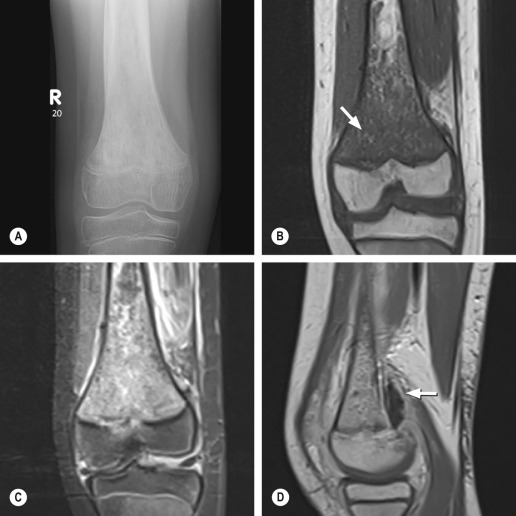
Post-surgical or interventional procedures cause bone signal changes that can persist for up to 12 months. Hence, whenever possible, MRI should be obtained before any interventions are performed, to avoid the need for additional procedures. Whole-body MRI may be useful to demonstrate multiple sites of involvement.
In early stages, three-phase technetium ( 99m Tc)-methylene diphosphonate (MDP) skeletal scintigraphy may be useful for demonstrating increased radioactivity in the affected bone and also for demonstrating multifocal disease. Increased activity may be seen in dynamic perfusion, early blood pool and delayed images. However, such uptake is non-specific and may be seen in other conditions, including trauma and tumours.
This uncommon form of non-bacterial inflammatory osteomyelitis occurs in children with a female predominance. The aetiology is not known, but may be related to autoimmune disorders due to its association with inflammatory bowel disease and psoriasis-like skin conditions. A genetic aetiology is also postulated due to an association with mutation of the LPIN2 gene. It is characterised by multifocal non-pyogenic inflammatory bone lesions and a clinical course of exacerbations and remissions. It is more common in the lower limbs and may be symmetrical. Metaphyseal lesions occur in approximately 75% of cases. Symptoms are vague and it may present as monoarthritis or polyarthritis. Other less frequently involved sites include the spine, clavicle, pelvis and mandible. When a single site of disease is present, the term chronic non-bacterial osteomyelitis is used. There may be mild elevation of inflammatory markers but laboratory diagnosis is generally unhelpful. Microbiology cultures are negative. Plain radiographs may reveal osteolytic lesions with surrounding sclerosis. Whole-body MRI can be helpful by identifying multiple sites of the disease, some of which may be asymptomatic. Typically, MRI reveals periostitis, bone marrow oedema and signs of transphysitis. Many lesions may heal spontaneously, though symptoms may persist for several years. Diagnosis is made by exclusion and from clinical history and typical radiological findings affecting multiple sites ( Fig. 46.5 ) and recurrent negative cultures and bone biopsy. Majeed syndrome is an autosomal recessive disorder comprising a triad of chronic recurrent multifocal osteomyelitis (CRMO), congenital dyserythropoietic anaemia and inflammatory dermatosis ( Summary Box 46.1 ).
Both are characterised by multifocal non-pyogenic inflammatory bone lesions and a clinical course of exacerbations and remissions.
Chronic recurrent multifocal osteomyelitis (CRMO) occurs predominantly in children and adolescents.
In CRMO, the most common sites of disease are the metaphyses of long bones, accounting for approximately 75%.
In synovitis, acne, pustulosis, hyperostosis and osteitis (SAPHO), the most common site involved is the upper anterior chest wall, which includes sternoclavicular joints, medial ends of the clavicle, costosternal junctions and manubriosternal joint. Spinal involvement is also common, often centred in the thoracic spine with contiguous vertebral involvement.
Identification of additional sites of asymptomatic disease involvement can aid in the diagnosis, especially when disease is present at typical locations. Therefore whole-body imaging should be performed when the diagnosis is considered.
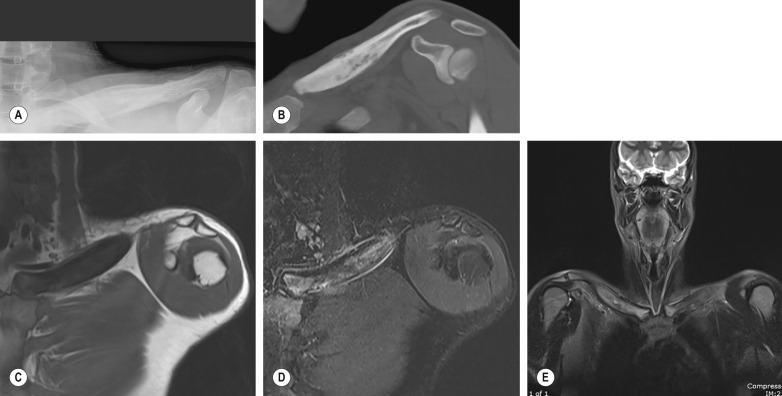
Like CRMO, synovitis, acne, pustulosis, hyperostosis and osteitis (SAPHO) is a complex inflammatory disorder with multifocal osteitis the predominant feature. It tends to affect 30 to 50 year olds with a female predominance. It is characterised by the presence of SAPHO. Skin manifestations and osteoarticular involvement commonly occur. Skin manifestation includes palmoplantar pustulosis and acne. There is bilateral symmetric pain and swelling of the bones and joints. The most common site involved is the upper anterior chest wall involved in 60%–95% of cases. This includes sternoclavicular joints, medial ends of the clavicle, costosternal junctions and manubriosternal joint. Spinal involvement is also common and is seen in 50% of the cases. It is often centred in the thoracic spine with contiguous vertebral involvement. The other sites of involvement include sacroiliac joints, long bones and mandible. The imaging features of SAPHO relate to synovitis, hyperostosis and osteitis. Whole-body MRI is useful to assess for asymptomatic sites of involvement and demonstrate the multifocal pattern of involvement. Biopsy demonstrates acute and chronic inflammatory cells. Relationship to Propionibacterium acnes has been postulated but is debatable. Treatment is by non-steroidal anti-inflammatory drugs (NSAIDs) in the first instance, but severe cases may need immunosuppressive treatment.
This is a chronic form of osteomyelitis, usually occurring in children, and commonly affects the mandible. This is considered as a form of CRMO affecting the mandible. Patients present with pain and hard swelling of the mandible. Initial findings include lytic lesions of the mandible associated with sclerosis. With disease progression there is non-suppurative ossifying periostitis with subperiosteal new bone formation and sclerosis. The diagnosis can be made presumptively by radiology, and biopsy reveals features of chronic osteomyelitis, with cultures usually negative.
This is a rapidly progressive life-threatening infection occurring in young children and more common in boys. This condition also occurs in adults. Risk factors include immunocompromise, diabetes, intravenous drugs or alcohol abuse and patients with peripheral vascular disease. The condition is polymicrobial in origin, and includes gram-positive aerobes like group A β-haemolytic streptococcus, S. aureus , gram-negative organisms like E. coli , Pseudomonas aeruginosa and anaerobes like Bacteroides . Clostridium infection leads to a gas-producing necrotic infection, gas gangrene, which is rapidly progressive and leads to systemic toxicity and shock. Characteristically, the gas is intramuscular in gas gangrene, giving rise to gas loculi that are elongated and aligned with the muscle fascicles, whilst more globular gas loculi are seen in fasciitis, when a gas-forming organism is present.
The infection involves deep subcutaneous tissues and is associated with a high mortality. Infection causes thrombosis of small blood vessels, leading to necrosis and rapidly involving several fascial planes. The condition has been associated with trauma, burns, eczema and varicella infections. The extensive soft-tissue damage leads to multiorgan failure and shock.
Ultrasound can be useful in diagnosing the abnormal muscle echo texture, but MRI is more reliable and is needed to assess the extent of tissue damage and demonstrate the spread of infection along the facial planes. CT may also be useful, but MRI is preferred due to better soft-tissue contrast and lack of radiation. Emergency surgical debridement is needed to stop the progress of this fulminating condition; relevant imaging must therefore be performed immediately.
Spontaneous musculoskeletal infections in adults are less common than in children and are usually due to trauma, previous surgery or underlying immunodeficiency disorders. Trauma and open wounds can result in seeding of bone with microorganisms and to development of osteomyelitis. Whilst haematogenous infection is common in childhood osteomyelitis, in adults, it is mostly responsible for vertebral osteomyelitis. Apart from trauma, infection can also develop in prosthetic implants after surgery. Underlying conditions like diabetes, vascular insufficiency, decubitus ulcers and sinuses can predispose to development of osteomyelitis in adults. Osteomyelitis is classified by the time since onset, as described earlier ( Summary Box 46.2 ).
Ultrasound is the preferred technique to investigate children with suspicion of septic arthritis. Ultrasound-guided aspiration is safe and easy to perform.
Magnetic resonance imaging is the preferred technique for early detection of osteomyelitis. The fat globule sign on T 1 weighted images is pathognomonic for acute osteomyelitis, whilst the penumbra sign is pathognomonic for a Brodie abscess in subacute osteomyelitis.
Computed tomography is useful in the evaluation of chronic osteomyelitis and provides information regarding intraosseous cavities which may contain a sequestrum with the surrounding reactive involucrum formation.
Diabetic foot osteomyelitis primarily arises from the contiguous spread of an overlying ulcer. On T 1 weighted images, low signal intensity in marrow adjacent to an ulcer or a sinus tract is the primary sign of osteomyelitis.
Healthy adult bone is usually resistant to infection, but when affected can be difficult to treat. The presence of dead bone and implants make it difficult to treat by antimicrobial agents and removal of the debris and the prosthetic implants is necessary to eradicate the infection. The bacteria attach to the bone matrix and orthopaedic implant devices by developing receptors to fibronectin and other structural proteins. They develop a slimy coat and a very slow metabolic rate, hide in intracellular locations and are thus able to elude host defences and antibiotics. The presence of implants also causes cell dysfunction, which decreases the ability of polymorphonuclear cells to phagocytise bacteria. Reactions between the bacteria and the host defences cause release of cytokines and consequent osteolysis.
Patients with sickle cell disease are prone to developing enteric bacterial osteomyelitis. In sickle cell disease, there is impaired gut defence due to sickling in the vasculature of gut. This enables the entry of organisms into the bloodstream, and haematogenous spread of infection into the bones. Typically this is Salmonella infection, but this probably reflects the prevalence of Salmonella in countries where sickle cell disease is common.
Clinical features are variable, but acute infections generally present with pain, swelling and redness of the affected area associated with systemic illness. Joint swelling, reduced mobility and features of overlying cellulitis may be present. In chronic infections, discharging sinuses may be present. Treatment may render chronic osteomyelitis inactive, but reactivation may occur, with recurrence of symptoms (pain, swelling, erythema, fever) and new radiographic features (bone destruction, periosteal reaction). Characteristic radiographic features of chronic osteomyelitis include intraosseous cavities that may contain separated fragments of necrotic bone (a sequestrum), with the surrounding bone becoming thickened and sclerotic (involucrum). The cavity may communicate with the surrounding soft tissue through cloacae in the involucrum, with sinus tracks to soft-tissue abscesses or cutaneous ulcers. Extrusion of sequestra may occur through these sinuses. The chronic ulcer associated with these sinuses can undergo malignant transformation into a squamous cell carcinoma ( Fig. 46.6 ).
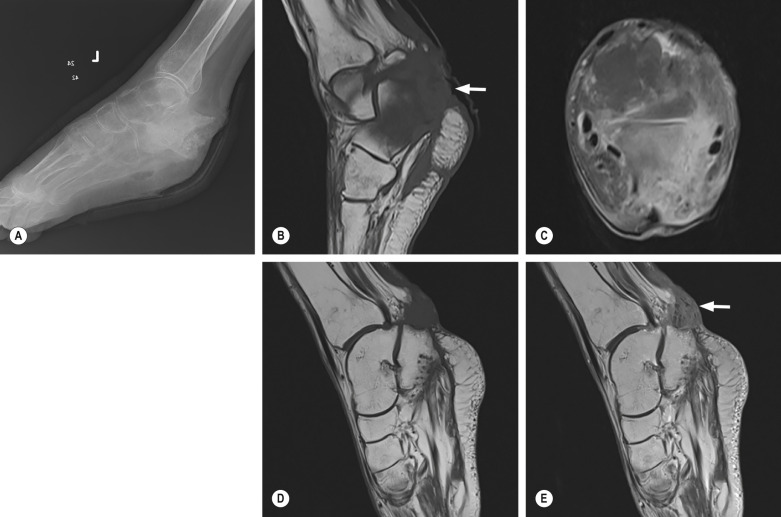
Become a Clinical Tree membership for Full access and enjoy Unlimited articles
If you are a member. Log in here